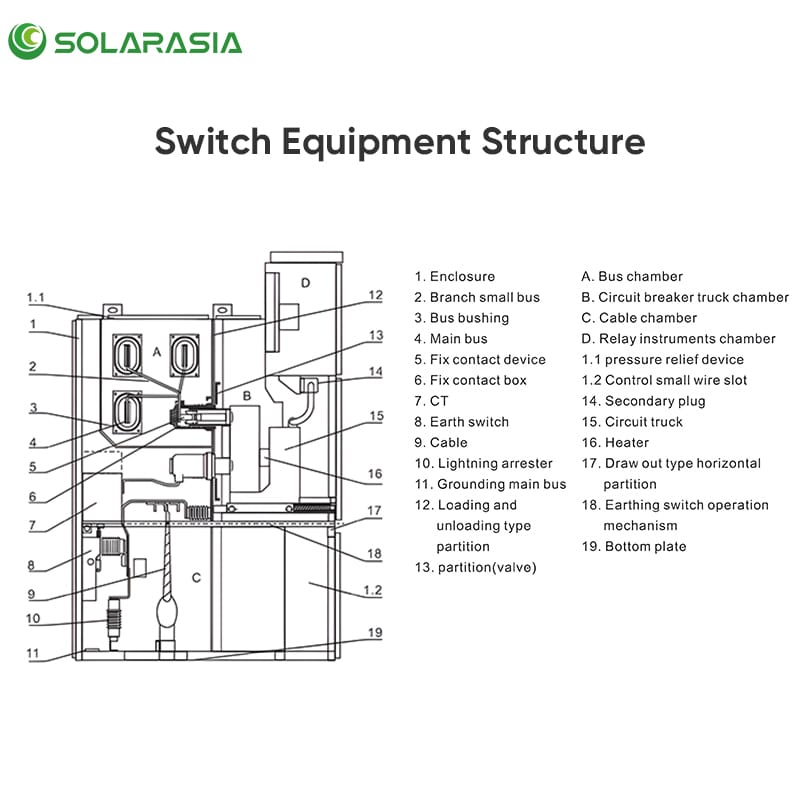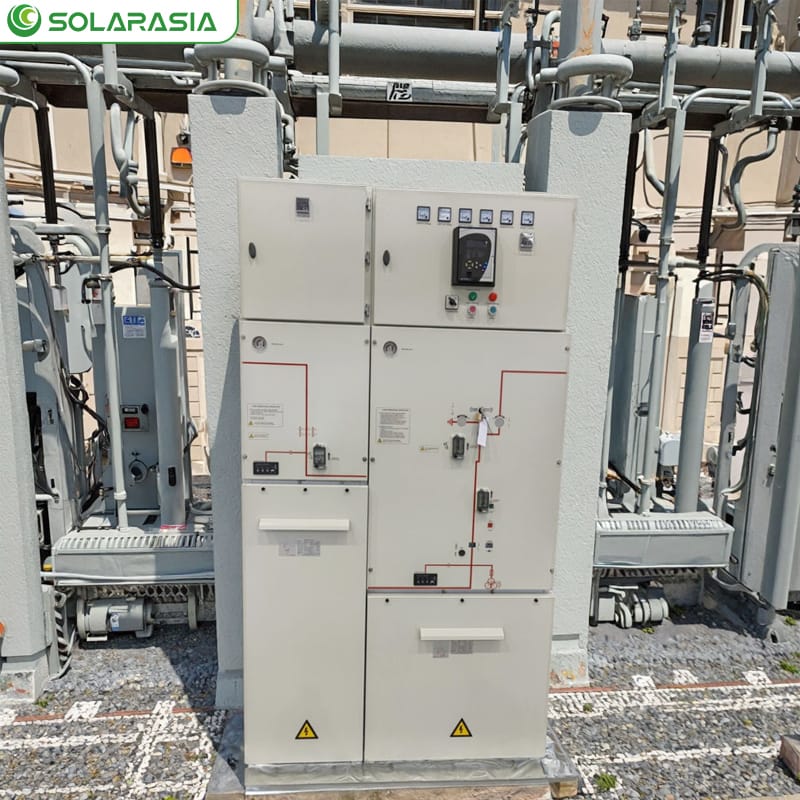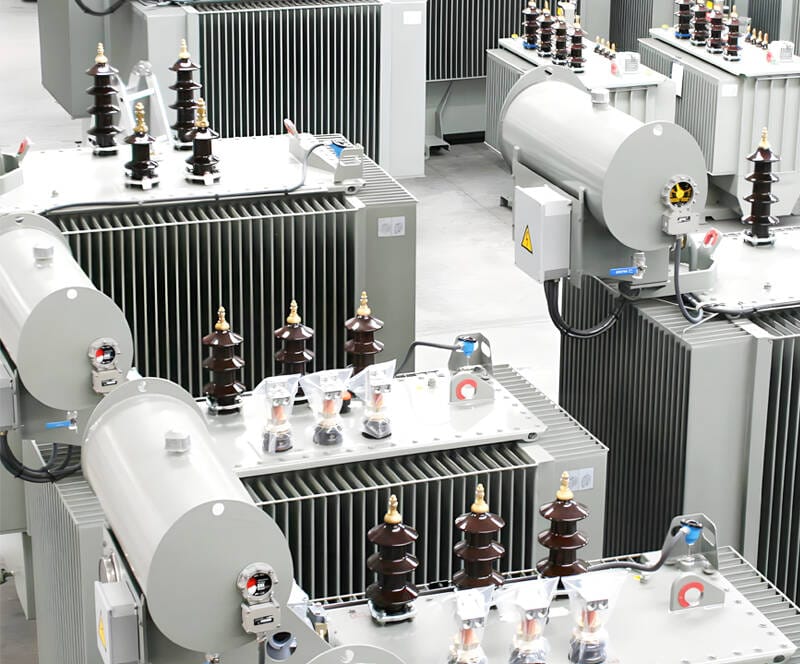I. Introduction
In today’s world, electrical energy is the fundamental driver behind industrial manufacturing, commercial operations, and everyday activities. From running large-scale data centers and industrial plants to supplying electricity to homes, a dependable and secure power distribution network is indispensable. Central to this intricate system is a critical element — switchgear.
Switchgear acts as the protective shield of the electrical network. It guarantees uninterrupted power transmission while safeguarding against equipment failure, electrical anomalies, and potential dangers. In its absence, even a minor electrical issue could rapidly develop into a major accident, leading to operational breakdowns, widespread power outages, or fire hazards.
As electrical infrastructures become increasingly sophisticated — incorporating renewable energy generation, automated controls, and digital supervision — the importance of switchgear has grown further. Specifically, recognizing the distinctions between High Voltage (HV) and Low Voltage (LV) switchgear enables engineers, operators, and decision-makers to make better-informed choices regarding system design, upkeep, and safety protocols.
This document examines the fundamental nature of switchgear, its categorization according to voltage ratings, and the key differentiators between high and low voltage systems — offering both technical clarity and practical knowledge.
II. What is Switchgear?
In simple terms, switchgear refers to an integrated collection of electrical components designed to manage, protect, and segregate electrical apparatus. It regulates the flow of electrical power, maintains safe functioning during standard operations, and activates automatically in response to fault conditions.
Consider it the nerve center and safety barrier of the power network — permitting personnel to energize or de-energize circuits, observe electrical parameters like voltage and current, and shield installations from harm due to short circuits, excessive loads, or insulation failures.
Primary Functions of Switchgear
Control:
Allows manual or automated operation of electrical circuits, supporting efficient functioning and servicing.
Protection:
Identifies irregular situations (such as short circuits, overloads, or insulation breakdown) and promptly isolates the affected segment to avoid damage.
Isolation:
Establishes a physical break in the circuit, enabling safe maintenance or examination without electrical risks.
Key Components of Switchgear
Circuit Breakers:Interrupt circuits automatically upon fault detection.
Isolators (Disconnect Switches):Ensure circuits are de-energized for safe maintenance work.
Fuses:Deliver overcurrent protection by interrupting the circuit when current surpasses predetermined levels.
Protective Relays:Sense abnormal operating conditions and initiate protective measures.
Control and Metering Instruments:Gauge and track system variables (e.g., voltage, current, frequency).
In summary, switchgear not only enhances the operational dependability of power networks but also secures the safety of personnel and assets. Whether in a generation facility or a compact commercial space, it operates as an unseen safeguard, continuously ensuring system integrity.

III. Categorization of Switchgear by Voltage Level
Switchgear can be grouped according to various criteria — such as functionality, mounting arrangement, or insulating medium — yet the most widespread and functional classification is based on voltage rating. Different voltage levels demand specific insulation capabilities, safety protocols, and hardware designs to assure consistent performance.
The following is a general breakdown aligned with international standards like IEC 62271 and IEEE C37:
| Category | Typical Voltage Range | Common Applications |
|---|---|---|
| Low Voltage (LV) Switchgear | Up to 1 kV (Commonly 400–690V) | Residential complexes, office buildings, data hubs, light industrial units |
| Medium Voltage (MV) Switchgear | 1 kV – 36 kV | Manufacturing plants, distribution substations, urban power grids |
| High Voltage (HV) Switchgear | Above 36 kV | Long-distance transmission lines, utility power plants, large renewable energy projects |
Understanding the System Hierarchy
Low Voltage (LV) systemsare responsible for the final stage of power delivery — supplying electricity directly to end-user appliances and machinery.
Medium Voltage (MV) systemsfunction as an intermediary link, connecting distribution substations to end-user premises.
High Voltage (HV) systemsare utilized for efficient long-distance bulk power transmission, moving substantial amounts of energy across extensive networks.
Each category entails unique engineering considerations — spanning insulation methods, arc-flash mitigation, installation settings, and maintenance demands. A clear understanding of these variations is essential for professionals to choose the appropriate switchgear for their specific electrical infrastructure.

IV. What is High Voltage Switchgear?
High Voltage (HV) Switchgear comprises electrical apparatus engineered to regulate, safeguard, and segregate circuits functioning at voltages exceeding 36 kV. It is predominantly deployed in transmission networks, electricity generation facilities, and major substations — locations requiring the secure and dependable management of substantial electrical power.
Defining Features of High Voltage Switchgear
Superior Insulation and Arc Management:
Owing to the elevated voltage levels, HV switchgear necessitates robust insulating materials and efficient arc-extinguishing systems. Common techniques such as SF₆ gas, vacuum, or air insulation are employed to contain electrical arcs during switching events.
Durable and Secure Build:
Typically constructed as metal-enclosed or gas-insulated switchgear (GIS), these systems are designed for optimum safety and dependability, even in demanding environments. GIS is especially favored for its space-saving design and reduced maintenance requirements.
Automated Operation and Remote Management:
HV installations are frequently controlled from centralized locations. Smart protective devices, sensors, and Supervisory Control and Data Acquisition (SCADA) systems facilitate automated fault identification and continuous performance monitoring.
Enhanced Operational Dependability:
Interruptions in transmission networks can lead to significant economic and functional disruptions. Consequently, HV switchgear is built for uninterrupted performance, often incorporating redundant elements and multiple protective layers.
Primary Usage Scenarios
- Transmission substations: For adjusting voltage levels between different network segments.
- Generation facilities: To safely link generators to the transmission network.
- Renewable energy installations: For connecting extensive solar or wind power projects to the grid.
- Major industrial complexes: Where a consistent high-voltage supply is essential.
Illustrative Example
For example, a substation handling 220 kV or 400 kV would employ an assembly of circuit breakers, instrument transformers, and protection relays — all consolidated within HV switchgear to guarantee regulated and protected electricity transfer.
High voltage switchgear constitutes the fundamental framework of national electricity transmission infrastructures, preserving the integrity of long-distance energy transfer and grid steadiness.
V. What is Low Voltage Switchgear?
Low Voltage (LV) Switchgear functions at voltages not exceeding 1,000 volts AC (1 kV) and is primarily utilized for distributing electrical power to final consumption points — spanning commercial establishments, residential buildings, industrial workshops, and control panels.
Distinguishing Attributes of Low Voltage Switchgear
Space-Efficient and Adaptable Configuration:
LV switchgear is commonly housed in indoor enclosures or panels, frequently combined with control systems. Its modular nature allows for adaptable setups to suit various load requirements and apparatus.
Straightforward Operation and Upkeep:
Designed for ease of use, it often supports manual control, although automated features are available for industrial applications. Maintenance procedures are generally swift and involve minimal service interruption.
Integrated Protective Functions:
It offers safeguards against short circuits, overloads, earth faults, and voltage variations. Standard components include Miniature Circuit Breakers (MCBs), Molded Case Circuit Breakers (MCCBs), and Air Circuit Breakers (ACBs).
Compatibility with Monitoring and Control Networks:
Contemporary LV assemblies often incorporate digital measurement, power consumption tracking, and communication ports for integration with Building Management Systems (BMS) or intelligent grid applications.
Frequently Used Elements
- Circuit breakers (MCB, MCCB, ACB)
- Contactors and control relays
- Busbar systems and distribution boards
- Surge protective devices
- Power factor correction equipment
- Monitoring and control instrumentation
Implementation Contexts
- Commercial properties: For lighting, climate control, lifts, and general power outlets.
- Industrial sites: Within Motor Control Centers (MCCs) to operate machinery and automated processes.
- Critical installations like data centers and hospitals: To ensure an uninterrupted and clean power source for vital operations.
- Residential communities: For the ultimate stage of power delivery to individual homes.
Illustrative Example
Within a sizable office complex, LV switchgear allocates 400V power from the main supply or transformer to various circuits serving lighting, elevators, and office equipment — while ensuring safety through integrated circuit breakers and control relays.
In essence, low voltage switchgear guarantees protected, effective, and consistent power supply at the point of consumption, representing the ultimate link in the electrical distribution sequence.

VI. How to Distinguish Between High and Low Voltage Switchgear
While both HV and LV switchgear share the core objectives of circuit management, protection, and isolation, they exhibit considerable differences in voltage rating, physical design, sophistication, expense, and maintenance protocols.
The following provides a structured comparison:
| Aspect | High Voltage Switchgear | Low Voltage Switchgear |
|---|---|---|
| Voltage Range | Above 36 kV | Up to 1 kV |
| System Function | Bulk power transmission and generation | End-user power distribution and equipment supply |
| Physical Construction | Large-scale, heavy-duty, often gas-insulated (GIS) or metal-enclosed | Compact, modular panels for indoor installation |
| Control Method | Primarily remote and automated | Manual or semi-automated |
| Insulation Medium | SF₆ gas, vacuum, or air | Air or solid insulation within molded casings |
| Safety Protocols | Sophisticated interlocks, arc-flash containment, specialized earthing | Fundamental protection against overcurrents and short circuits |
| Maintenance Needs | Demands specialized personnel and advanced procedures | Simpler, lower-risk, and routine upkeep |
| Installation Environment | Outdoor substations or generation facilities | Indoor electrical rooms or enclosures |
| Cost and Physical Size | Higher investment, significant space requirement | More economical, reduced footprint and modular |
Summary
HV Switchgear:Employed for extensive power transmission and high-capacity uses, where operational reliability and insulation capability are paramount.
LV Switchgear:Used for localized power distribution and apparatus safeguarding, emphasizing user accessibility, operational safety, and functional simplicity.
Grasping these differences is vital for technical professionals, system planners, and facility operators when choosing suitable switchgear, thereby ensuring desired performance, safety, and effectiveness across all segments of the electrical network.
VII. Safety and Maintenance Considerations
Safety represents the foremost concern in all electrical installations, particularly those involving switchgear. Both high and low voltage systems present substantial hazards if improperly managed — including electrical shock, arc flash incidents, and equipment malfunctions. Implementing appropriate safety protocols and maintenance regimes ensures personnel safety while enhancing system dependability and operational lifespan.
Essential Safety Measures
Adequate Insulation and Grounding Systems:
All switchgear assemblies must be properly insulated and grounded to mitigate electric shock risks and arc-related hazards. High-voltage installations demand particularly advanced insulation materials and comprehensive earthing systems.
Strict Lockout/Tagout (LOTO) Protocols:
Before commencing maintenance activities, circuits must be securely isolated and clearly marked with warning tags to prevent unintended re-energization.
Arc Flash Risk Mitigation:
Switchgear enclosures, protective relays, and arc detection systems work collectively to identify and suppress arc events. Appropriate Personal Protective Equipment (PPE) — including arc-rated garments and face protection — is essential for technical staff.
Restricted Access to Qualified Personnel:
High-voltage switchgear operation and maintenance should be exclusively performed by certified engineers or adequately trained specialists. While LV systems present lower risks, strict adherence to safety standards remains imperative.
Recommended Maintenance Approaches
Scheduled Visual Examinations:Regularly inspect for loose connections, signs of corrosion, accumulated dust, or moisture presence within enclosures.
Thermal Imaging Surveys:Deploy infrared cameras to identify overheating components before they lead to system failures.
Functional Testing and Calibration:Conduct routine testing of protective relays, circuit breakers, and insulation resistance measurements.
Comprehensive Documentation:Maintain detailed service records to support regulatory compliance and performance analysis.
Proactive maintenance strategies not only diminish accident potential but also prolong switchgear operational life, thereby reducing expensive operational disruptions and repair costs.
VIII. Future Trends in Switchgear Technology
The switchgear sector is experiencing significant transformation, propelled by digitalization, environmental sustainability demands, and renewable energy integration. Several key developments are shaping its trajectory:
1. Digitalization and Intelligent Switchgear
Contemporary systems are evolving into smart switchgear platforms incorporating sensors, Internet of Things (IoT) connectivity, and advanced analytics. These intelligent systems continuously monitor parameters such as temperature, humidity, and current flow — facilitating predictive maintenance strategies and decreasing unexpected outages.
2. Environmentally Sustainable Insulation Solutions
Conventional high-voltage switchgear frequently utilizes SF₆ gas for insulation. However, since SF₆ represents a potent greenhouse gas, the industry is transitioning toward SF₆-free alternatives, including vacuum interruption and clean air insulation technologies, supporting carbon reduction objectives.
3. Space-Optimized and Modular Architectures
Increasing urban density and complex industrial requirements are driving demand for compact switchgear solutions. Modular designs enable rapid installation, straightforward expansion, and seamless integration with existing infrastructure.
4. Renewable Energy and Smart Grid Integration
Switchgear now assumes a vital role in connecting renewable generation sources — including solar arrays, wind turbines, and energy storage systems — to electrical networks. Intelligent switchgear enhances grid adaptability, accommodating bidirectional power flows and distributed generation models.
5. Strengthened Cybersecurity Measures
As digital connectivity increases, so does the requirement for robust cybersecurity. Modern switchgear systems incorporate secure communication protocols and network protection measures to defend against cyber threats and data compromises.
The next generation of switchgear will actively monitor its performance, diagnose potential issues, and adjust dynamically to changing system conditions — combining intelligence, sustainability, and adaptability.
IX. Conclusion
Switchgear constitutes much more than an assembly of electrical components — it represents the fundamental control system of power distribution networks. It ensures the secure, efficient, and reliable delivery of electrical energy from generation sources to end-users.
High voltage switchgear provides the structural foundation for extensive transmission networks, managing substantial power transfers across extended distances.
Conversely, low voltage switchgear acts as the ultimate protective barrier at the consumption level — regulating and safeguarding equipment in residential, commercial, and industrial settings.
By comprehending the distinctions between these systems — including their voltage classifications, structural designs, safety requirements, and operational methodologies — engineering professionals and project planners can develop solutions that maximize performance, reduce service interruptions, and ensure sustained reliability.
As technological progress continues, switchgear will increasingly embrace digital intelligence, environmental sustainability, and advanced functionality — contributing to safer and more ecologically responsible global power infrastructures.



